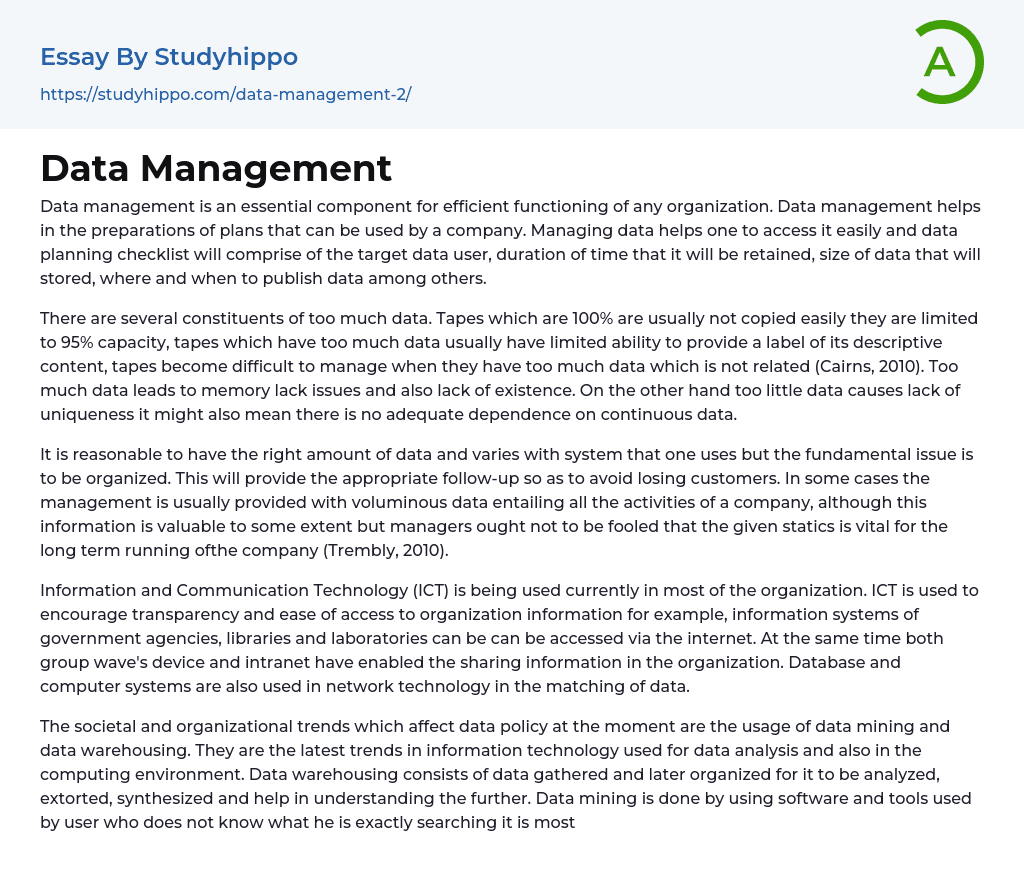Data management is crucial for the efficient operation of any organization. It aids in the development of plans that can be utilized by a company. Managing data facilitates easy access, and a data planning checklist includes factors such as the intended data user, duration of retention, storage size, and publication details.
There are several factors associated with an excess of data. When tapes contain 100% capacity, they are not easily copied and are limited to 95% capacity. Additionally, tapes with excessive data often lack the ability to provide a label describing their content, making them challenging to manage. These issues can lead to memory shortages and even nonexistence. Conversely, insufficient data results in a lack of uniqueness and may indicate a lack of dependence on continuous data. It is essential to have the right amount of organized data, which can vary depending on the system being used. This organization ens
...ures proper follow-up and prevents customer loss. Although some managers may receive extensive data encompassing all company activities, they should not be deceived into thinking that this statistic alone is crucial for long-term company operations. Currently, Information and Communication Technology (ICT) is widely utilized in organizations. ICT promotes transparency and accessibility to organizational information through platforms like government agency information systems, libraries, and laboratories accessible via the internet. Moreover, both group wave's device and intranet enable information sharing within an organization.Database and computer systems play a significant role in network technology, facilitating the matching of data. Currently, data policy is influenced by societal and organizational trends such as the utilization of data mining and data warehousing. These trends are cutting-edge in the realm of information technology an
are employed for data analysis within the computing environment.
In data warehousing, information is gathered and organized for subsequent analysis, extraction, synthesis, and enhanced understanding. On the other hand, data mining involves the use of software and tools by users who may not have a precise query in mind. It is primarily used to identify trends and patterns, like determining purchasing habits through the analysis of customer sales information.
Effectively managing data necessitates consistency and integration during the data collection process. Sustainable diligence, confidentiality, and security are paramount in data management. Organizations that excel at data management typically prioritize data collection since gathering comprehensive and reliable data ensures its relevance to all stakeholders (Institute of Medicine, 2005).Distributed data offers several advantages, such as reducing communication costs by locating data closer to its usage and allowing for different storage systems (Institute of Medicine, 2005). However, there are drawbacks to distributing data, including the need for multifaceted software in a distributed database environment and potential slow processing if data is not correctly formatted.
In contrast, centralized data has its own set of advantages. For example, a server customized for Database Management Systems (DBMS) can yield optimal results, and both database and application processing can occur simultaneously. Additionally, one server machine can be accessed by multiple server machines. However, centralized data also has disadvantages; if not stored properly, data can become corrupted, and servers must have sufficient capacity to accommodate more clients.
Overall, effective data management encompasses more than just data mining and warehousing; it also includes data modeling, movement, and administration. By managing data effectively, organizations can ensure they have the appropriate amount of data, avoiding an excess or a shortage,
leading to improved efficiency in company operations.
- Leadership and Management essays
- Change Management essays
- Project Management essays
- Knowledge Management essays
- Operations Management essays
- Quality Management essays
- Risk Management essays
- Scientific Management essays
- supply chain management essays
- Performance Management essays
- Time Management essays
- Brand Management essays
- Total Quality Management essays
- Risk essays
- Manager essays
- Leadership essays
- Business Ethics essays
- Board Of Directors essays
- Product Management essays
- Comparative Analysis essays
- Decision Making essays
- Dispute Resolution essays
- Stress Management essays
- Business Management essays
- Brand Equity essays
- Branding essays
- Nike, Inc. essays
- Market share essays
- Razor essays
- Being A Leader essays
- Servant Leadership essays
- Leadership Experience essays
- Leadership Qualities essays
- Incentive essays
- Data Modeling essays
- Data Warehouse essays
- Operator essays
- Relation essays
- Sql essays
- Cloud Computing essays
- Computer Science essays
- Consumer Electronics essays
- Data Analysis essays
- Electronics essays
- engineering essays
- Enterprise Technology essays
- Hardware essays
- Impact of Technology essays
- Information Age essays
- Information Technology essays




